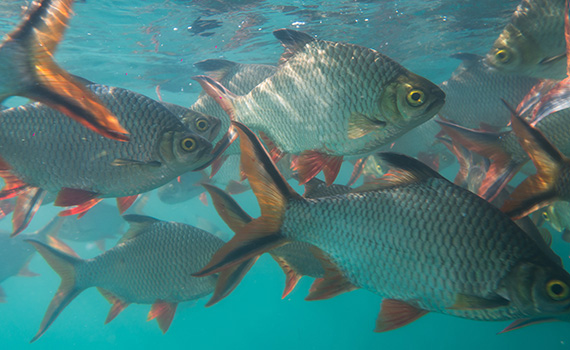
Vaccine progress critical to sustainable freshwater aquaculture in Southeast Asia
A lack of vaccines and susceptibility to bacterial pathogens is putting Southeast Asia’s booming freshwater farming industry at risk, according to scientists.
Freshwater fish production accounts for a third of the region’s total aquaculture output, but with registered vaccines only available in Vietnam and Indonesia, new and practical immunization options for fish farmers are essential, researchers at Kasetsart University, Bangkok, said.
In a study reviewing vaccine development for three of the most prevalent pathogens affecting Nile tilapia and striped catfish — Streptococcus agalactiae, Edwardsiella ictalurid and Flavobacterium columnare — the researchers found significant barriers to mass immunization.
However, they also highlighted significant advancements in epidemiological understanding, mucosal response and vaccine delivery that could be applied in the region.
Live-vaccine alternatives sought
While live-attenuated vaccines (LAV) are the most common tool for controlling infectious diseases, this is not the case in aquaculture, the researchers said.
Commercial applications of LAV are strictly prohibited in Southeast Asia, with critics arguing that pathogens may regain virulence through genetic mutation.
There has been some progress in treating S. agalactiae infection — most commonly seen in more intensive tilapia aquaculture — using LAV through oral administration and immersion, they noted. For now, however, lack of access means producers tend to seek out alternative treatments.
These alternatives include inactivated vaccine with booster, which studies suggest may be the best option to provide long-lasting immunity against piscine streptococcosis, the researchers said.
“Interestingly, the memory of vaccination could vertically transfer from the parents to offspring, but vaccine efficacy was related significantly to the gonadal stages of brooders,” they added.
As pathogen serotype is crucial to vaccine efficacy, the research team said further cross-country collaboration is essential to fully understand S. agalactiae genetic diversity. Greater success could be possible using vaccines including different serotypes, they added, while sub-unit vaccines using pathogen DNA or proteins offer promising alternatives to both LAV and whole-cell inactivated vaccines.
Treating growing catfish problem needs more data
Another pathogen that has relatively recently affected striped catfish in Southeast Asia is E. ictalurid, which the researchers noted has also been detected in other regional fish species such as Nile tilapia and red hybrid tilapia. The disease it causes, bacillary necrosis of pangasius (BNP), can cause high losses, while anti-microbial resistance underlines the importance of vaccines.
As Eic genetics can vary considerably across regions, collecting systemic and high-resolution data is critical, the researchers added, although vaccine design needs to be based on the specific challenges of each country.
Clues from US aquaculture’s septicaemia fight
For insights on how to treat BNP in juvenile striped catfish, the team looked to decades of data from mass vaccination programs in the US against enteric septicaemia of catfish (ESC), which is also caused by E. ictalurid.
Typically, catfish are given a live vaccine against ESC at a young age, with a booster administered once their immune systems are more developed.
The ban on commercial LAV use means this approach will not be adopted in Southeast Asia any time soon, the researchers acknowledged. Instead, they suggested work should focus on the exploration of DNA vaccines or improved inactivated vaccines for E. ictalurid.
Better targeting needed for columnaris disease
Attempts to develop a suitable vaccine against F. columnare, the bacterium which causes columnaris disease and can result in mortality rates of up to 70%, have produced variable results, they said.
The bacteria’s exceptionally high genetic diversity means that regardless of regulatory status, the few commercial LAV available in the US would not be suitable for use in the region.
As the disease mainly affects fry and fingerling, which are too small for parenteral vaccination, immersion is the most common preventative measure. This has proven relatively difficult to achieve using inactivated vaccines, the researchers explained, though new techniques to improve adhesion to fish mucosal pathways may result in more effective options for treating the region’s major species.
‘Very few licensed vaccines are available’
Despite the wealth of experimental vaccines being explored in Southeast Asia, the researchers stressed that in practice, vaccines tend to be locally prescribed and that fundamental hurdles need to be overcome before commercial options can be developed.
“It is quite alarming that in the countries where fish cultivation has been practiced for many decades, very few licensed vaccines are available,” they concluded.
“This is probably due to many factors such as slow registration process, availability of delivery system and cost effectiveness. These issues must be urgently investigated so disease protection by vaccination strategy can be applied with aquaculture in this region.”
To view the full study report published in Fish & Shellfish Immunology, click here.
Posted on: September 15, 2021






